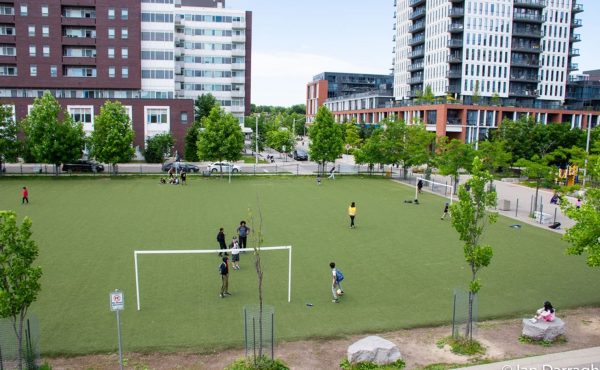
This regular online series will feature interviews with fascinating and influential urban thinkers, with a focus on discussing how Toronto can become a more engaged, accessible, sustainable city.
Artscape is a not for profit developer that creates live and work spaces exclusively for artists. Its Toronto-based projects include the Artscape Triangle Lofts, Wychwood Barns, and Artscape Distillery Studios. Two additional projects are presently in development: The Shaw Street School and Regent Park Arts and Culture Centre. Spacing sat down with Tim Jones, President and CEO of Artscape, to discuss these projects and the role that artists play in city life.
Spacing: Is artist live-work space still threatened in Toronto?
Jones: Artscape was born in the mid-1980s during both a housing boom and crack down on illegal artist live-work spaces. We’re experiencing a similar boom today, in that warehouse buildings, which would have previously provided fantastic live-work spaces for artists, are being converted to lofts or offices instead. Artscape works with artists to give them greater control over their situation. We’re all familiar with the so-called “Soho Effect:” Artists move into a neighbourhood, make it trendy and are then priced out. The story is also told with the same sad lament of artists as victims of urban development. We’re trying to overturn the artists-as-victims motif. For the better part of a decade, artists in Toronto have been declaring, “we are agents of change and we’re generating value.” We’ve been working with public and private entities in order to assert artist’s interests and find a place for them within communities. The best example is the redevelopment of Wychwood Barns where the living and work needs of artists have been accommodated: Artists are placed at the centre of community where they can thrive. The Barns has also proven that artists can generate value and make a tremendous community contribution.
Spacing: How is Artscape able to provide affordable accommodation for artists?
Jones: People in the property management business are shocked to hear that Artscape’s “vacancy loss” over the last 10 years equals less than half a percent. Property managers in the private sector, by contrast, might budget three percent a year to compensate for people abandoning their leases. The Artscape model is based on the micro-finance principle that if you lend money to poor people they’ll pay it back. Artists, in particular, appreciate the fact that you’re leasing them space while keeping it affordable and they recognize that the model only works when everyone pays the rent.
Our goal is to provide affordable housing without creating “bottom of the barrel” space. We’re trying to generate the conditions for creative people to thrive. For that reason, we maintain a spectrum of affordability with short-term rentals like Gibraltar Point, to new membership-based models where you only pay for the studio time that you’re using. It’s a range of below-market options recognizing the different financial capabilities within the arts community.
Spacing: What kinds of buildings does Artscape consider in terms of creating new live-work space for artists?
Jones: Old brick and beam buildings have great potential but there are fewer of them available and they’re hot commodities now. Increasingly, we’re looking at new construction, like the Regent Park Arts and Culture Centre. Another good example is the City’s plan for a cultural-creative hub in Weston Mount Dennis. The City engaged us last year to do a study on creative hubs in priority neighbourhoods, like Weston. They launched a design charette and a planning exercise in partnership with the Urban Land Institute. The site they selected is currently a Green P parking lot. Before construction starts, we’ll first consider the best composition for the new space by engaging both interested artists and the community.
Spacing: Can you tell us more about the Regent Park Arts and Culture Centre?
Jones: Regent Park represents a failed model of social and urban planning. Nonetheless, when government decided to demolish it and start anew there were still some overriding concerns, for instance, how to integrate arts and culture. The Centre will attempt to tap into the power of the arts to drive an agenda for growth and change in Regent Park, but will do so in a way that also aligns it with the needs of the arts community. Artscape’s involvement is also meant to compliment public policy agendas in terms of building social infrastructure and creating better social cohesion. On the ground floor, the new centre will contain space residents can use to stage their own work including a 450-seat flexible performance event area. The centre will also contain offices for two community arts organizations: Native Earth Performing Arts and Collective of Black Artists. The second floor is designed to engage youth and provide them with arts training. We’re also accommodating groups that have been active in the community for years, like ArtHeart, the Regent Park School of Music, Cabbagetown and Regent Park Museum, and the Regent Park Film Festival.
Spacing: What can you tell us about the Shaw Street School?
Jones: At the moment were trying to discover the right mix of uses and figuring out how to repurpose an old building. With Shaw we set up a community advisory committee, as we always have, and put out a call for proposals for people who might be interested in leasing or owning space. It’s through that process that we discovered who is interested and what vision will apply. One of the biggest challenges with Shaw was its 14 ft. wide hallways that make up 40% of the building. It’s generally inefficient as work space. Eventually we realized that the hallways could actually be central to the plan. They can be alive as big living rooms or as galleries. There is that old Jane Jacobs adage about old spaces needing new ideas: That’s really the case with Shaw. Its about finding out what the ideas are and how they inform the structure.
Spacing: Why are artists so critical to the dynamic of cities?
Jones: Artists help us tell our stories and are the lifeblood of community. They bring cultural value to our communities. If you look at Queen West, much of whats unique about Toronto was pretty much born there ― music, fashion, design. Arts is also big business in Toronto. Presently, the arts and culture sector accounts for 6% of our workforce and over $9 billion in GDP. We’re just starting to really appreciate the size of this growing sector. We’ve always kind of took it for granted that we had a vibrant arts scene but now it’s important for our economic future.
Photo by False Positives





3 comments
I have a studio at the Artscape Wychwood Barns. The studio is 221 square feet with no natural light, no possibility for exhaust ventilation (eg. Oil painters dont qualify for the studios), low cieling, no sink just 4 walls. You are not alowed to use it as a retail space. I pay $527 per month with yarly increases of 3.5%. It is about time for some jurnalist to do his reasearch and stop perpetuating Artscapes PR capmpain. Talk to artists, and find out wether they are thriving in these spaces. No jurnalist has done that yet but large amounts of public funding are funeled towards Artscape.
Hmmm I believe the Jane Jacobs quote used in this article may be reversed. I believe it should read:
Old ideas can sometimes use new buildings. New ideas must use old buildings.
Here’s the full quote:
“Cities need old buildings so badly it is probably impossible for vigorous streets and districts to grow without them. By old buildings I mean not museum-piece old buildings, not old buildings in an excellent and expensive state of rehabilitation–although these make fine ingredients–but also a good lot of plain, ordinary, low-value old buildings, including some rundown old buildings.
If a city area has only new buildings, the enterprises that can exist there are automatically limited to those that can support the high costs of new construction. These high costs of occupying new buildings may be levied in the form of an owner’s interest and amortization payments on the capital costs of the construction. However the costs are paid off, they have to be paid off. And for this reason, enterprises that support the cost of new construction must be capable of paying a relatively high overhead–high in comparison to that necessarily required by old buildings. To support such high overheads, the enterprises must be either (a) high profit or (b) well subsidized.
If you look about, you will see that only operations that are well established, high-turnover, standardized or heavily subsidized can afford, commonly, to carry the costs of new construction. Chain stores, chain restaurants and banks go into new construction. But neighborhood bars, foreign restaurants and pawn shops go into older buildings. . . . Well-subsidized opera and art museums often go into new buildings. But the unformalized feeders of the arts–studios, galleries, stores for musical instruments and art supplies, backrooms where the low earning power of a seat and a table can absorb uneconomic discussions–these go into old buildings. Perhaps more significant, hundreds of ordinary enterprises, necessary to the safety and public life of streets and neighborhoods, and appreciated for their convenience and personal quality, can make out successfully in old buildings, but are inexorably slain by the high overhead of new construction.
As for really new ideas of any kind–no matter how ultimately profitable or otherwise successful some of them might prove to be–there is no leeway for such chancy trial, error and experimentation in the high-overhead economy of new construction. Old ideas can sometimes use new buildings. New ideas must use old buildings.”
http://misspreservation.com/2009/03/19/book-quotes-jane-jacobs-on-old-buildings/
I completely agree with the former artist’s comment. Jones might talk a good game in theory, but the artists’ work needs are not first among Artscape’s practical considerations. Neither do we have much control over our situation. And as a result, we are definitely NOT thriving. The Wychwood Barns are a work in progress right now, and should Artscape continue to care more about going forward with ever larger and more ambitious projects at the cost of managing the others well, you’ll see how fast your “vacancy loss” rises.